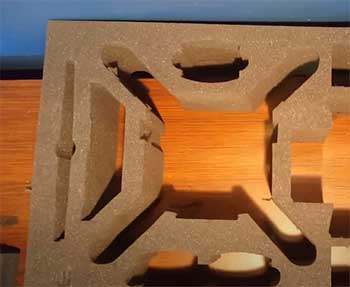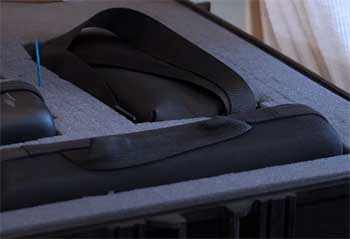Issues with the pelican case foam? Looking for alternatives? You’re not alone. A lot of people don’t like the pelican case foam lining or grow weary of them.
Which is why there’s a pretty big selection of alternatives. Replacement foam, plywood, foam, and styrene are some common alternatives.
The classic pick-and-pluck foam lining for pelican cases doesn’t work for everyone. If you’re one of those people or simply want to cut down on costs, this is for you.
Foam Alternatives For Pelican Cases
Here’s a list of foam alternatives for Pelican cases:
- Replacement Foam
- Plywood And Foam
- Styrene
Here’s a detailed look at the alternatives. Let’s see how they actually hold up.
- Replacement Foam

This is an overall good option if you’re not opposed to using foam as lining.
Whether you skipped the original foam for budget or it wore down, replacement foam has your back.
There are lots of options and variety so you can pick one that suits you easily.
Replacement foam can mean two things. One is the pre-cut foam lining you can find in stores.
The other is the type you DIY from scratch.
If you’re looking to replace your worn-out lining, then the first one is probably the better option because that will be more precise.
Replacement foams come in lots of options. A lot of shops sell foam linings for pelican cases. You just have to match your case model and you’ll be done.
Some brands have foam blocks you’ll have to DIY. Kaizen is the top name among them. Kaizen is also the cheapest name-brand foam so that’s a bonus.
But if they don’t fit your budget, you can go for non-brand foam liners. They may not be the same quality but they get the shock absorption job done.
These are pre-made options. If you don’t want the hassle of ordering from a different shop, you can get some mattress foam from your nearest furniture shop.
You’ll have full control over customization so you can fit them however you want. And if you’re not a DIY person, you can give them your measurements to make one for you.
Also Read: Differences Between Pelican 1615 And 1650 Cases.
- Plywood And Foam

If the main problem with your foam lining was the measurements or dividers, this will do wonders for you.
Plywood and foam are a surprising combo, but they work.
It holds the structure and absorbs shock pretty well (depending on what foam you’re using).
This combo is completely DIY. You’ll get the plywood board and closed-cell foams from a supplier but that’s it.
Start with cutting the plywood board into pieces.
Cut them according to the compartment design you have in mind. If you want convenience, cut the pieces in a way that they slot into each other.
Glue the plywood pieces with strong glue, something like industrial-grade epoxy. Cut some small holes in the boards to ensure ventilation.
Then comes the tricky part, you have to attach the foam to the plywood structure. It is better to use cement glues for this. Once you’re done, dry them off and set them in the box.
The problem with this hack is that the foam layer takes forever to dry. You’ll need multiple days so if you’re in an emergency, this may not be the best solution.
Plus there is next to zero room for error. If you screw up the divider (or the foam layer) once, you’ll have to start again for better alignment.
Another problem is, this is a very hands-on alternative. You’ll have to build everything from scratch so you’ll definitely need to get your hands dirty.
And of course, you’ll need lots of time. But that may not be for everyone. So in terms of convenience, this one doesn’t go very far.
- Styrene
Styrene is a pretty good alternative, but it is temporary. It is easy to work with and you can get them pretty much anywhere.
They definitely won’t last for multiple years like foam, but they’re a good temporary solution, especially for one-way travel.
Styrene is pretty shock-absorbent but it can be bulky. Styrene is also hard to bend and shape if you’re using straight sheets (or blocks). So if you want rounded edges, you’ll have to look for pre-cut styrene sheets.
The biggest plus point of styrene is that it is easy to assemble. All you have to do is cut the pieces and glue them together with industrial-grade glue.
This is also the cheapest option on this list so if you’re really tight on budget, you can go for this.
The problem is, styrene isn’t long-lasting. You can use it and it will absorb shock to some extent, but it won’t go back to its initial state like foam. Which means if it breaks, it breaks.
And since styrene isn’t really flexible, it breaks a lot too (or at least wears off).
Another problem is durability. How durable the styrene is depended on its thickness. But you can’t use something too thick or it will take up all the space inside. You’ll have to balance between durability and bulkiness to find your best option.
For a temporary solution like styrene, finding the right thickness takes a little too much work.
Is The Original Pelican Case Foam Worth It?
There are lots of reasons why people look for foam alternatives. The built-in pick-and-pluck foam usually works, but it can start crumbling after a while.

Some people also go for empty cases to cut off some costs. That means they need a structure from the scratch.
Fortunately, you have seen lots of good alternatives to the original foam.
Replacement foam, plywood, foam, and styrene are all good alternatives.
All you’ll have to do is MacGyver your way through the situation.
You know the alternatives, you know what you should look for in them. But what if you didn’t reach for the alternatives in the first place? Is the original foam lining worth keeping?
The answer is yes. The usual foam lining for pelican cases might cost insanely high, but they’re worth the money. The foam is shock absorbent, precisely cut, and comes in different designs.
Matching the case model is the only thing you’ll have to do.
Plus the original liners last a good amount of time, so it is a win really. Unless you’re in a budget pinch, want a customized lining design, or need a temporary solution; the original liner is the most convenient option you’ll find for your pelican case.
So, is the original foam lining worth it? Very much, yes. Feel free to get a case with lining if you’re willing to give them a shot.
Also Read: Differences Between Pelican And Apache 4800 Case.
Frequently Asked Questions (FAQ)
Here are a bunch of questions people ask about Pelican case foam and its alternatives.
Most Pelican cases use the pick-and-pluck foam for inner linings. And if you want official names, polyurethane and polyethylene are the most common types of foams used in pelican cases.
Any weatherproof and hard shell case is similar to pelican cases. But if you want names, Nanuk and Seahorse are the top contenders.
Pelican foam is made of polyurethane. Polyurethane is a kind of open-cell foam with a high shock absorption rating.
That comes down to personal preferences, but they’re really close in terms of quality.
Final Verdict
Whether you want to replace the old lining or want to ditch it completely, there are lots of options you can choose from. Just make sure you’re choosing a proper Pelican case foam alternative that fits your case and you’ll be good.

